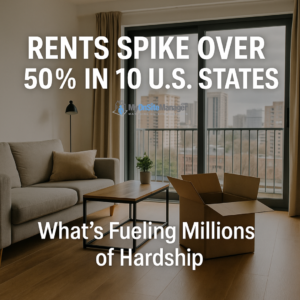Over the last five years, the cost of renting a home in the United States has skyrocketed — and for residents in at least 10 U.S. states, the increase has been nothing short of jaw-dropping.
According to newly released data from Rentec Direct, featured in Newsweek, these states have seen rent increases of more than 50% between 2019 and 2024 — with some topping 80%. This isn’t just a statistic—it’s a financial reality reshaping millions of lives.
States Hit the Hardest
Here are the 10 states where median monthly rent rose more than 50%:
| State | % Increase (2019–2024) | New Median Rent |
|---|---|---|
| Arizona | +84% | ~$1,641 |
| Tennessee | +67% | ~$1,280 |
| New Mexico | +66% | ~$1,150 |
| Georgia | +64% | ~$1,368 |
| Maryland | +61% | ~$1,015 |
| South Carolina | +57% | ~$1,260 |
| Alaska | +56% | ~$1,265 |
| Idaho | +56% | ~$1,200 |
| Montana | +54% | ~$1,350 |
| Wyoming | +51% | ~$1,050 |
Arizona leads the pack, with rent jumping from around $891 to $1,641—a monthly increase of over $750 in just five years.
Why Are Rents Rising So Fast?
Several key factors are fueling this rent surge:
1. Population Growth and Migration Trends
-
States like Arizona, Tennessee, and Georgia have become magnets for people relocating from more expensive coastal cities.
-
Many are drawn by job opportunities, lower taxes, and better weather—driving up demand and prices.
2. Low Housing Supply
-
Supply hasn’t kept up with demand.
-
Years of underbuilding after the 2008 recession left a shortage of affordable homes.
-
The pandemic further stalled construction, creating a bottleneck effect in many fast-growing states.
3. Lack of Rent Control
-
None of the 10 states with the highest rent increases have statewide rent control laws.
-
In unregulated markets, landlords can freely adjust rents based on market pressures—often with little notice to tenants.
4. Remote Work Shifts
-
Remote and hybrid work allowed renters to move to more affordable cities.
-
Ironically, the influx drove prices up in those once-affordable locations.
What Does This Look Like in Real Dollars?
To put the increase into perspective:
-
In Arizona, rent increased by roughly $750 per month, or $9,000 per year.
-
In Maryland, rents rose by an average of $383 per month.
-
Even in smaller or less densely populated states like Montana and Wyoming, tenants are paying hundreds more than they were just five years ago.
Not All States Followed the Trend
Interestingly, a few states have managed to keep rent increases in check—or even reduce them:
| State | % Change | Notable Trends |
|---|---|---|
| Minnesota | −34% | Aggressive housing policy and development efforts |
| Louisiana | −2.5% | Median rent dipped from $846 to $825 |
| New York | +13% | Rent control and stabilization measures played a role |
Minnesota’s example shows that pro-housing policies—including zoning reform and upzoning for multifamily housing—can curb runaway rent increases.
What Does the Future Hold?
While no one can predict the rental market with certainty, experts are watching a few key indicators:
-
Inflation and Interest Rates: As inflation slows and interest rates stabilize, rent increases may ease—but not reverse.
-
New Construction: More housing supply is critical. Local governments that fast-track development may see relief sooner.
-
Policy Interventions: States that enact rent control, housing vouchers, or zoning reform may help renters breathe a little easier.
Without bold action, renters in these high-growth states could face another 50% jump by 2030.
Why This Matters
These rent increases don’t just hit wallets—they shape entire communities:
-
Working-class families are being pushed out of historically affordable areas.
-
Landlords and property managers are navigating rising tenant turnover and affordability pressures.
-
Local governments are grappling with homelessness and housing insecurity.
Whether you’re a renter, homeowner, investor, or policymaker, understanding these trends is key to preparing for what’s ahead.
Final Thoughts
The last five years have reshaped the U.S. rental landscape, especially in regions that once offered affordability. If you’re living in one of these 10 states—or considering a move there—it’s more important than ever to:
-
Stay informed on local housing policy.
-
Budget for rapid changes in living costs.
-
Push for sustainable development and tenant protections.
Source: Newsweek: Map Shows States Where Rent Increased by More Than 50 Percent

